Stigma and Discrimination on Individuals With Mental Illness in Australia
VerifiedAdded on 2022/09/14
|9
|1776
|12
AI Summary
Contribute Materials
Your contribution can guide someone’s learning journey. Share your
documents today.
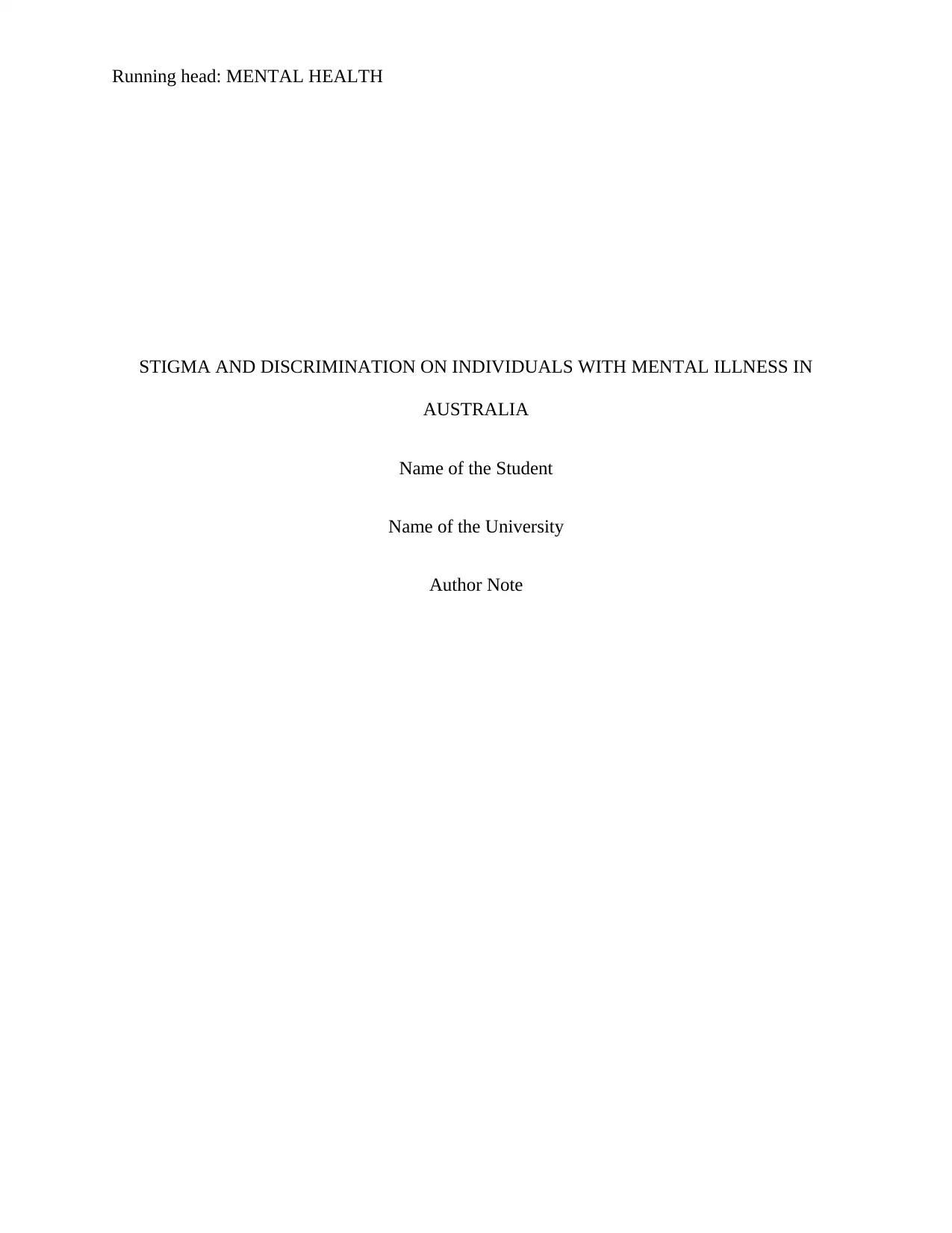
Running head: MENTAL HEALTH
STIGMA AND DISCRIMINATION ON INDIVIDUALS WITH MENTAL ILLNESS IN
AUSTRALIA
Name of the Student
Name of the University
Author Note
STIGMA AND DISCRIMINATION ON INDIVIDUALS WITH MENTAL ILLNESS IN
AUSTRALIA
Name of the Student
Name of the University
Author Note
Secure Best Marks with AI Grader
Need help grading? Try our AI Grader for instant feedback on your assignments.
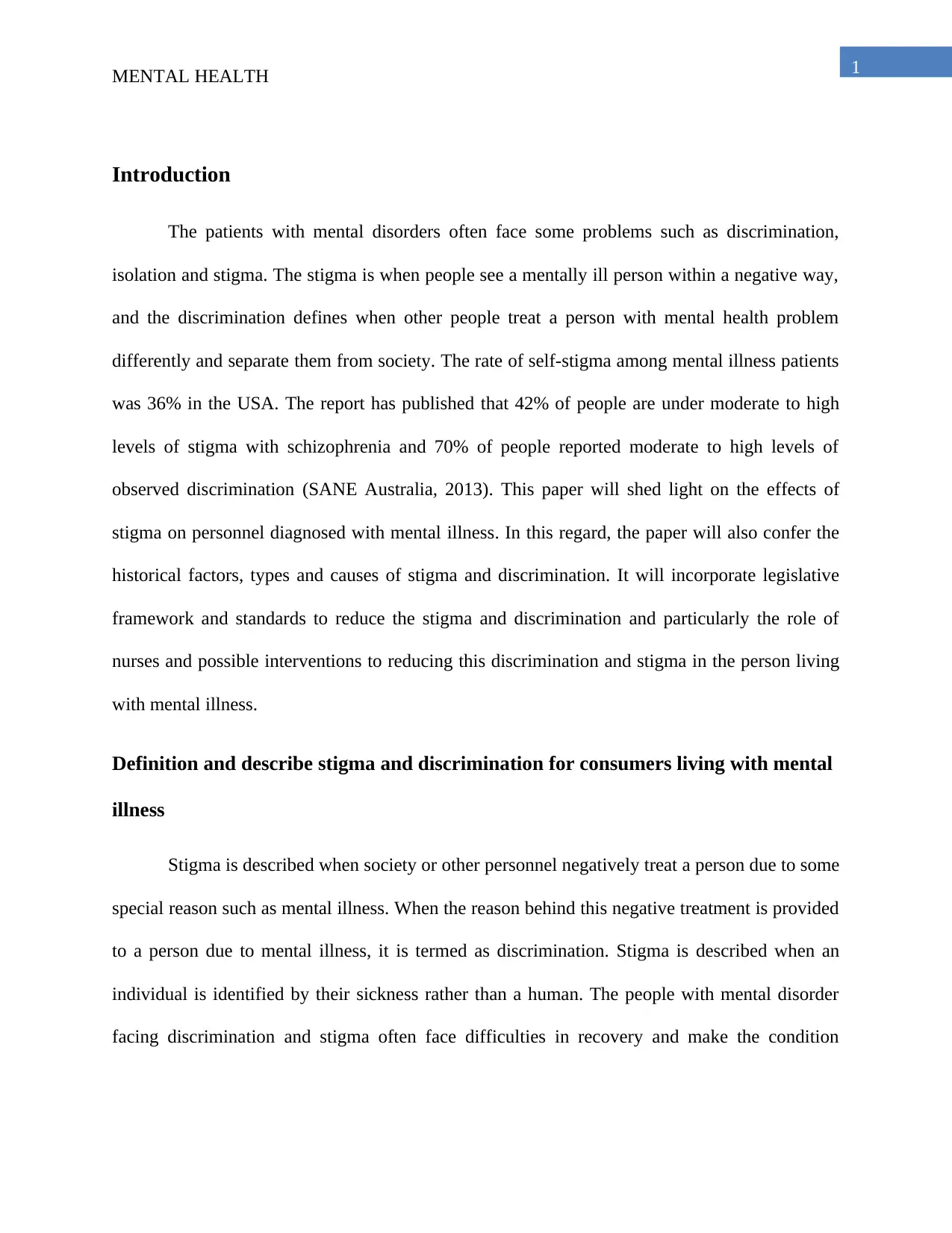
1
MENTAL HEALTH
Introduction
The patients with mental disorders often face some problems such as discrimination,
isolation and stigma. The stigma is when people see a mentally ill person within a negative way,
and the discrimination defines when other people treat a person with mental health problem
differently and separate them from society. The rate of self-stigma among mental illness patients
was 36% in the USA. The report has published that 42% of people are under moderate to high
levels of stigma with schizophrenia and 70% of people reported moderate to high levels of
observed discrimination (SANE Australia, 2013). This paper will shed light on the effects of
stigma on personnel diagnosed with mental illness. In this regard, the paper will also confer the
historical factors, types and causes of stigma and discrimination. It will incorporate legislative
framework and standards to reduce the stigma and discrimination and particularly the role of
nurses and possible interventions to reducing this discrimination and stigma in the person living
with mental illness.
Definition and describe stigma and discrimination for consumers living with mental
illness
Stigma is described when society or other personnel negatively treat a person due to some
special reason such as mental illness. When the reason behind this negative treatment is provided
to a person due to mental illness, it is termed as discrimination. Stigma is described when an
individual is identified by their sickness rather than a human. The people with mental disorder
facing discrimination and stigma often face difficulties in recovery and make the condition
MENTAL HEALTH
Introduction
The patients with mental disorders often face some problems such as discrimination,
isolation and stigma. The stigma is when people see a mentally ill person within a negative way,
and the discrimination defines when other people treat a person with mental health problem
differently and separate them from society. The rate of self-stigma among mental illness patients
was 36% in the USA. The report has published that 42% of people are under moderate to high
levels of stigma with schizophrenia and 70% of people reported moderate to high levels of
observed discrimination (SANE Australia, 2013). This paper will shed light on the effects of
stigma on personnel diagnosed with mental illness. In this regard, the paper will also confer the
historical factors, types and causes of stigma and discrimination. It will incorporate legislative
framework and standards to reduce the stigma and discrimination and particularly the role of
nurses and possible interventions to reducing this discrimination and stigma in the person living
with mental illness.
Definition and describe stigma and discrimination for consumers living with mental
illness
Stigma is described when society or other personnel negatively treat a person due to some
special reason such as mental illness. When the reason behind this negative treatment is provided
to a person due to mental illness, it is termed as discrimination. Stigma is described when an
individual is identified by their sickness rather than a human. The people with mental disorder
facing discrimination and stigma often face difficulties in recovery and make the condition
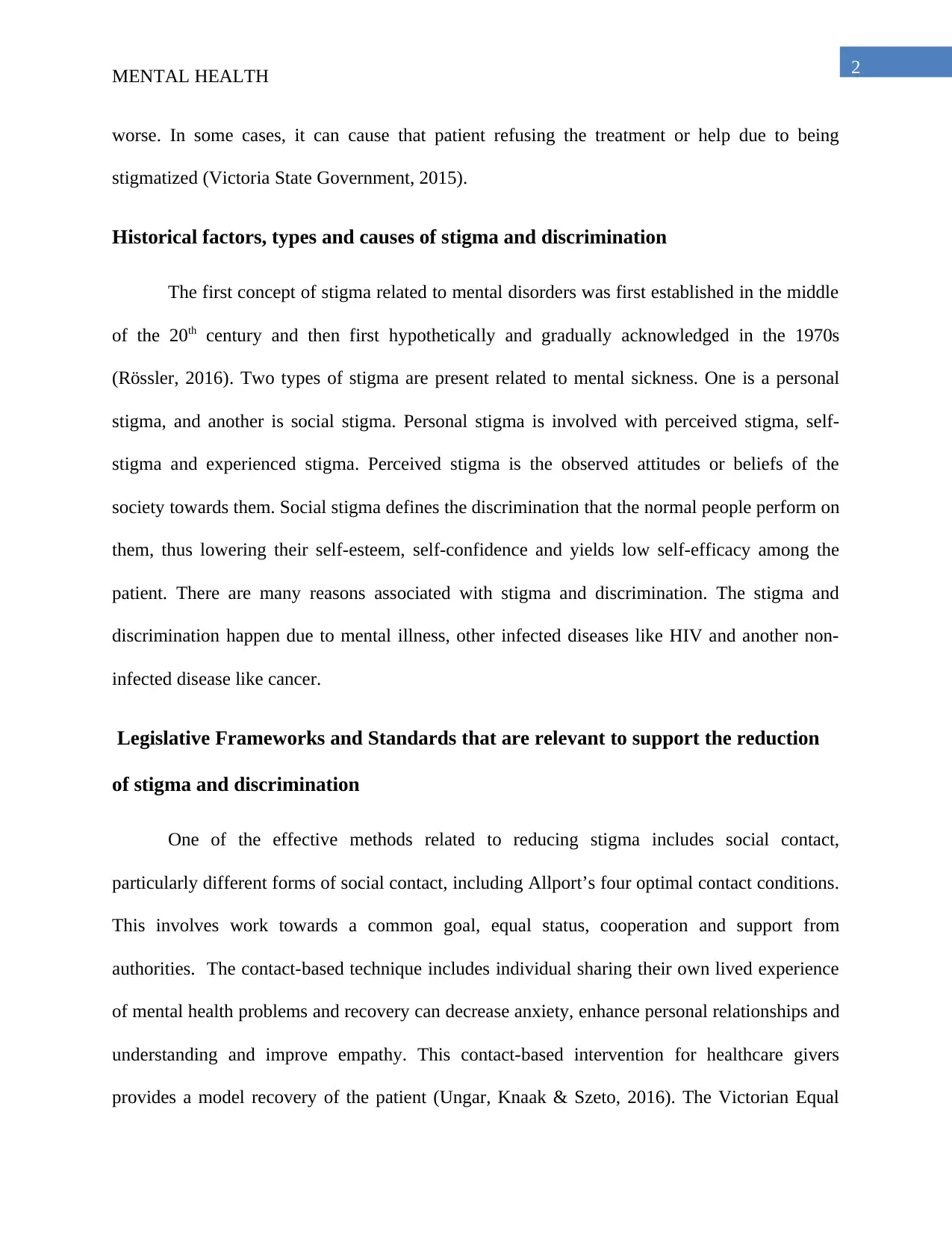
2
MENTAL HEALTH
worse. In some cases, it can cause that patient refusing the treatment or help due to being
stigmatized (Victoria State Government, 2015).
Historical factors, types and causes of stigma and discrimination
The first concept of stigma related to mental disorders was first established in the middle
of the 20th century and then first hypothetically and gradually acknowledged in the 1970s
(Rössler, 2016). Two types of stigma are present related to mental sickness. One is a personal
stigma, and another is social stigma. Personal stigma is involved with perceived stigma, self-
stigma and experienced stigma. Perceived stigma is the observed attitudes or beliefs of the
society towards them. Social stigma defines the discrimination that the normal people perform on
them, thus lowering their self-esteem, self-confidence and yields low self-efficacy among the
patient. There are many reasons associated with stigma and discrimination. The stigma and
discrimination happen due to mental illness, other infected diseases like HIV and another non-
infected disease like cancer.
Legislative Frameworks and Standards that are relevant to support the reduction
of stigma and discrimination
One of the effective methods related to reducing stigma includes social contact,
particularly different forms of social contact, including Allport’s four optimal contact conditions.
This involves work towards a common goal, equal status, cooperation and support from
authorities. The contact-based technique includes individual sharing their own lived experience
of mental health problems and recovery can decrease anxiety, enhance personal relationships and
understanding and improve empathy. This contact-based intervention for healthcare givers
provides a model recovery of the patient (Ungar, Knaak & Szeto, 2016). The Victorian Equal
MENTAL HEALTH
worse. In some cases, it can cause that patient refusing the treatment or help due to being
stigmatized (Victoria State Government, 2015).
Historical factors, types and causes of stigma and discrimination
The first concept of stigma related to mental disorders was first established in the middle
of the 20th century and then first hypothetically and gradually acknowledged in the 1970s
(Rössler, 2016). Two types of stigma are present related to mental sickness. One is a personal
stigma, and another is social stigma. Personal stigma is involved with perceived stigma, self-
stigma and experienced stigma. Perceived stigma is the observed attitudes or beliefs of the
society towards them. Social stigma defines the discrimination that the normal people perform on
them, thus lowering their self-esteem, self-confidence and yields low self-efficacy among the
patient. There are many reasons associated with stigma and discrimination. The stigma and
discrimination happen due to mental illness, other infected diseases like HIV and another non-
infected disease like cancer.
Legislative Frameworks and Standards that are relevant to support the reduction
of stigma and discrimination
One of the effective methods related to reducing stigma includes social contact,
particularly different forms of social contact, including Allport’s four optimal contact conditions.
This involves work towards a common goal, equal status, cooperation and support from
authorities. The contact-based technique includes individual sharing their own lived experience
of mental health problems and recovery can decrease anxiety, enhance personal relationships and
understanding and improve empathy. This contact-based intervention for healthcare givers
provides a model recovery of the patient (Ungar, Knaak & Szeto, 2016). The Victorian Equal
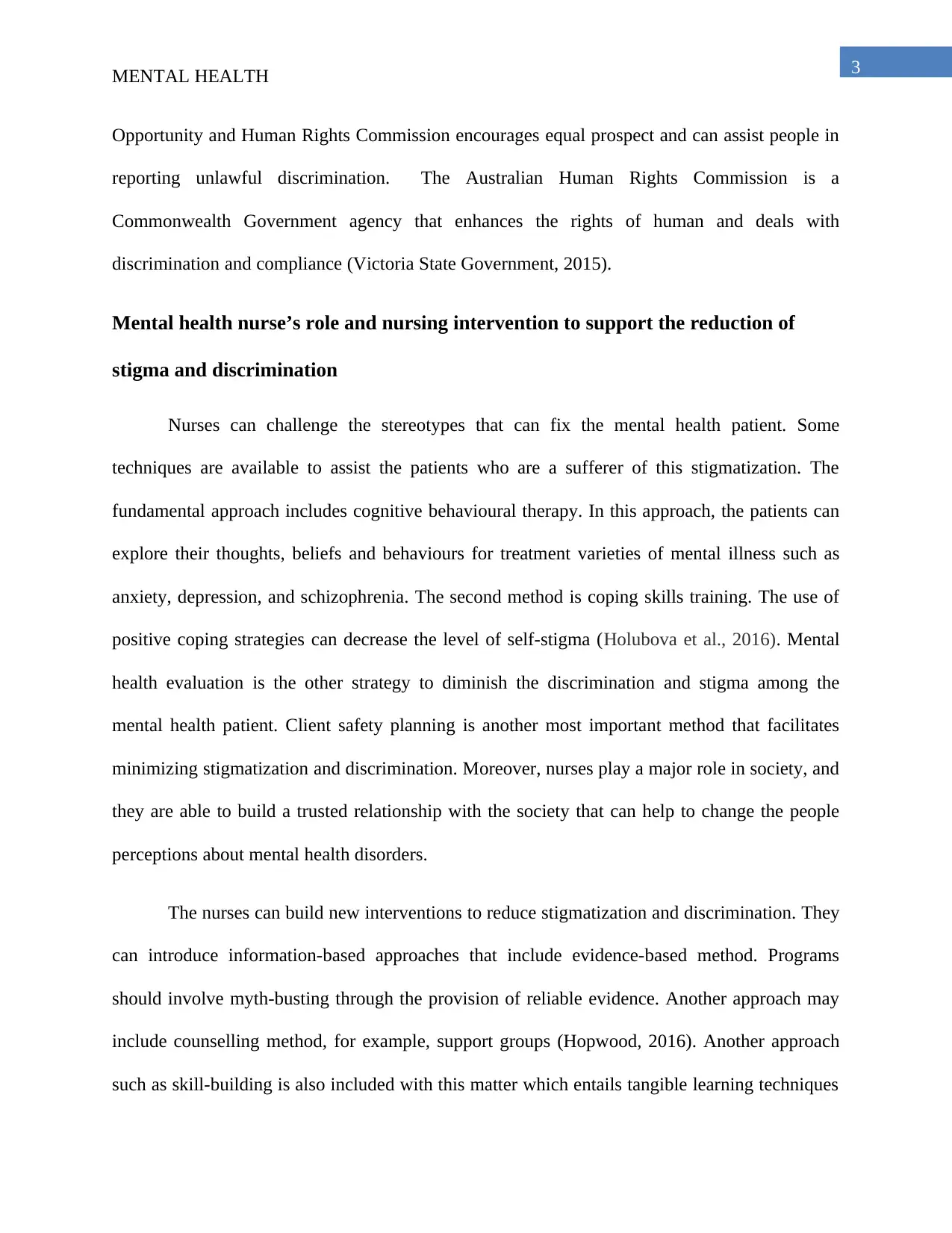
3
MENTAL HEALTH
Opportunity and Human Rights Commission encourages equal prospect and can assist people in
reporting unlawful discrimination. The Australian Human Rights Commission is a
Commonwealth Government agency that enhances the rights of human and deals with
discrimination and compliance (Victoria State Government, 2015).
Mental health nurse’s role and nursing intervention to support the reduction of
stigma and discrimination
Nurses can challenge the stereotypes that can fix the mental health patient. Some
techniques are available to assist the patients who are a sufferer of this stigmatization. The
fundamental approach includes cognitive behavioural therapy. In this approach, the patients can
explore their thoughts, beliefs and behaviours for treatment varieties of mental illness such as
anxiety, depression, and schizophrenia. The second method is coping skills training. The use of
positive coping strategies can decrease the level of self-stigma (Holubova et al., 2016). Mental
health evaluation is the other strategy to diminish the discrimination and stigma among the
mental health patient. Client safety planning is another most important method that facilitates
minimizing stigmatization and discrimination. Moreover, nurses play a major role in society, and
they are able to build a trusted relationship with the society that can help to change the people
perceptions about mental health disorders.
The nurses can build new interventions to reduce stigmatization and discrimination. They
can introduce information-based approaches that include evidence-based method. Programs
should involve myth-busting through the provision of reliable evidence. Another approach may
include counselling method, for example, support groups (Hopwood, 2016). Another approach
such as skill-building is also included with this matter which entails tangible learning techniques
MENTAL HEALTH
Opportunity and Human Rights Commission encourages equal prospect and can assist people in
reporting unlawful discrimination. The Australian Human Rights Commission is a
Commonwealth Government agency that enhances the rights of human and deals with
discrimination and compliance (Victoria State Government, 2015).
Mental health nurse’s role and nursing intervention to support the reduction of
stigma and discrimination
Nurses can challenge the stereotypes that can fix the mental health patient. Some
techniques are available to assist the patients who are a sufferer of this stigmatization. The
fundamental approach includes cognitive behavioural therapy. In this approach, the patients can
explore their thoughts, beliefs and behaviours for treatment varieties of mental illness such as
anxiety, depression, and schizophrenia. The second method is coping skills training. The use of
positive coping strategies can decrease the level of self-stigma (Holubova et al., 2016). Mental
health evaluation is the other strategy to diminish the discrimination and stigma among the
mental health patient. Client safety planning is another most important method that facilitates
minimizing stigmatization and discrimination. Moreover, nurses play a major role in society, and
they are able to build a trusted relationship with the society that can help to change the people
perceptions about mental health disorders.
The nurses can build new interventions to reduce stigmatization and discrimination. They
can introduce information-based approaches that include evidence-based method. Programs
should involve myth-busting through the provision of reliable evidence. Another approach may
include counselling method, for example, support groups (Hopwood, 2016). Another approach
such as skill-building is also included with this matter which entails tangible learning techniques
Secure Best Marks with AI Grader
Need help grading? Try our AI Grader for instant feedback on your assignments.
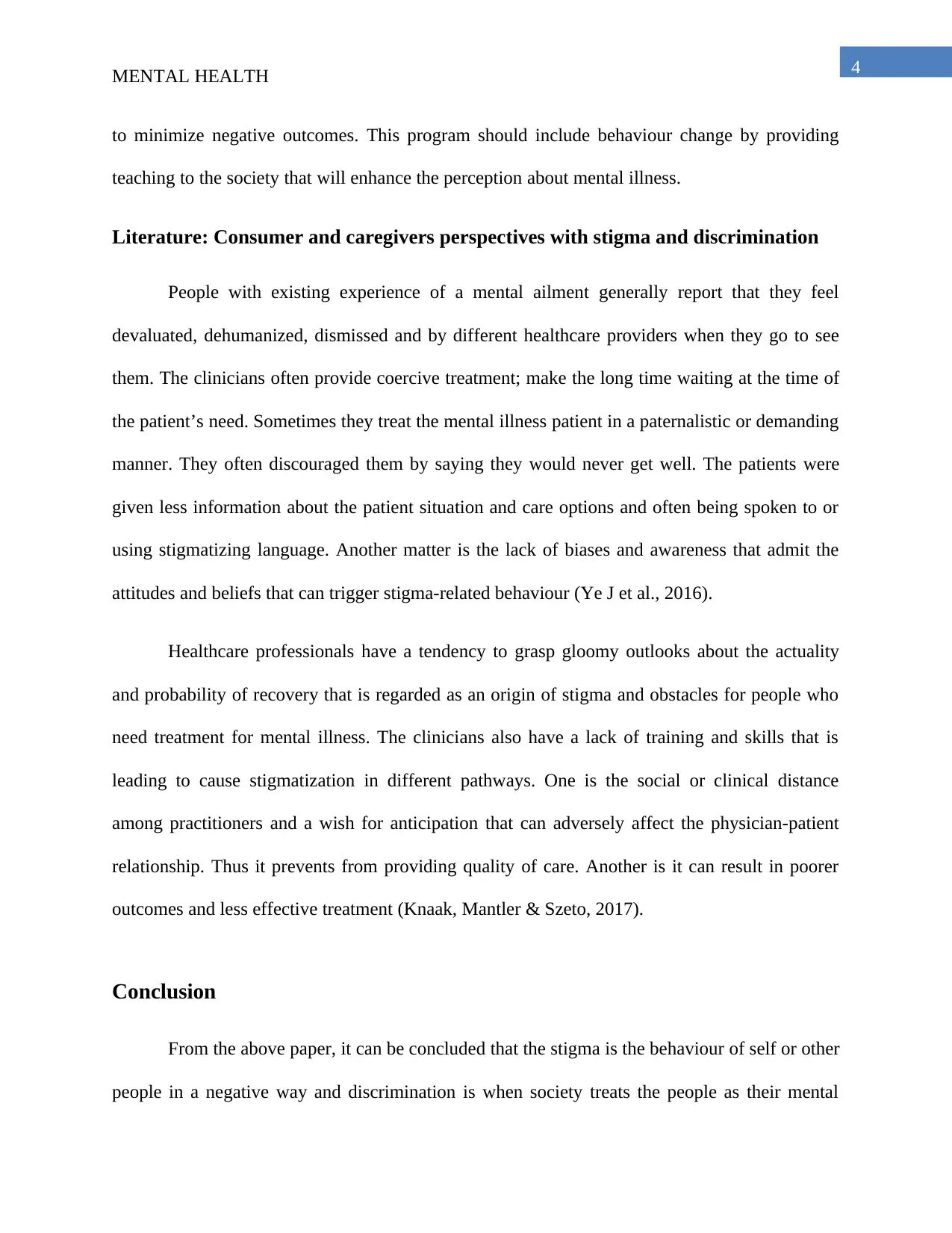
4
MENTAL HEALTH
to minimize negative outcomes. This program should include behaviour change by providing
teaching to the society that will enhance the perception about mental illness.
Literature: Consumer and caregivers perspectives with stigma and discrimination
People with existing experience of a mental ailment generally report that they feel
devaluated, dehumanized, dismissed and by different healthcare providers when they go to see
them. The clinicians often provide coercive treatment; make the long time waiting at the time of
the patient’s need. Sometimes they treat the mental illness patient in a paternalistic or demanding
manner. They often discouraged them by saying they would never get well. The patients were
given less information about the patient situation and care options and often being spoken to or
using stigmatizing language. Another matter is the lack of biases and awareness that admit the
attitudes and beliefs that can trigger stigma-related behaviour (Ye J et al., 2016).
Healthcare professionals have a tendency to grasp gloomy outlooks about the actuality
and probability of recovery that is regarded as an origin of stigma and obstacles for people who
need treatment for mental illness. The clinicians also have a lack of training and skills that is
leading to cause stigmatization in different pathways. One is the social or clinical distance
among practitioners and a wish for anticipation that can adversely affect the physician-patient
relationship. Thus it prevents from providing quality of care. Another is it can result in poorer
outcomes and less effective treatment (Knaak, Mantler & Szeto, 2017).
Conclusion
From the above paper, it can be concluded that the stigma is the behaviour of self or other
people in a negative way and discrimination is when society treats the people as their mental
MENTAL HEALTH
to minimize negative outcomes. This program should include behaviour change by providing
teaching to the society that will enhance the perception about mental illness.
Literature: Consumer and caregivers perspectives with stigma and discrimination
People with existing experience of a mental ailment generally report that they feel
devaluated, dehumanized, dismissed and by different healthcare providers when they go to see
them. The clinicians often provide coercive treatment; make the long time waiting at the time of
the patient’s need. Sometimes they treat the mental illness patient in a paternalistic or demanding
manner. They often discouraged them by saying they would never get well. The patients were
given less information about the patient situation and care options and often being spoken to or
using stigmatizing language. Another matter is the lack of biases and awareness that admit the
attitudes and beliefs that can trigger stigma-related behaviour (Ye J et al., 2016).
Healthcare professionals have a tendency to grasp gloomy outlooks about the actuality
and probability of recovery that is regarded as an origin of stigma and obstacles for people who
need treatment for mental illness. The clinicians also have a lack of training and skills that is
leading to cause stigmatization in different pathways. One is the social or clinical distance
among practitioners and a wish for anticipation that can adversely affect the physician-patient
relationship. Thus it prevents from providing quality of care. Another is it can result in poorer
outcomes and less effective treatment (Knaak, Mantler & Szeto, 2017).
Conclusion
From the above paper, it can be concluded that the stigma is the behaviour of self or other
people in a negative way and discrimination is when society treats the people as their mental
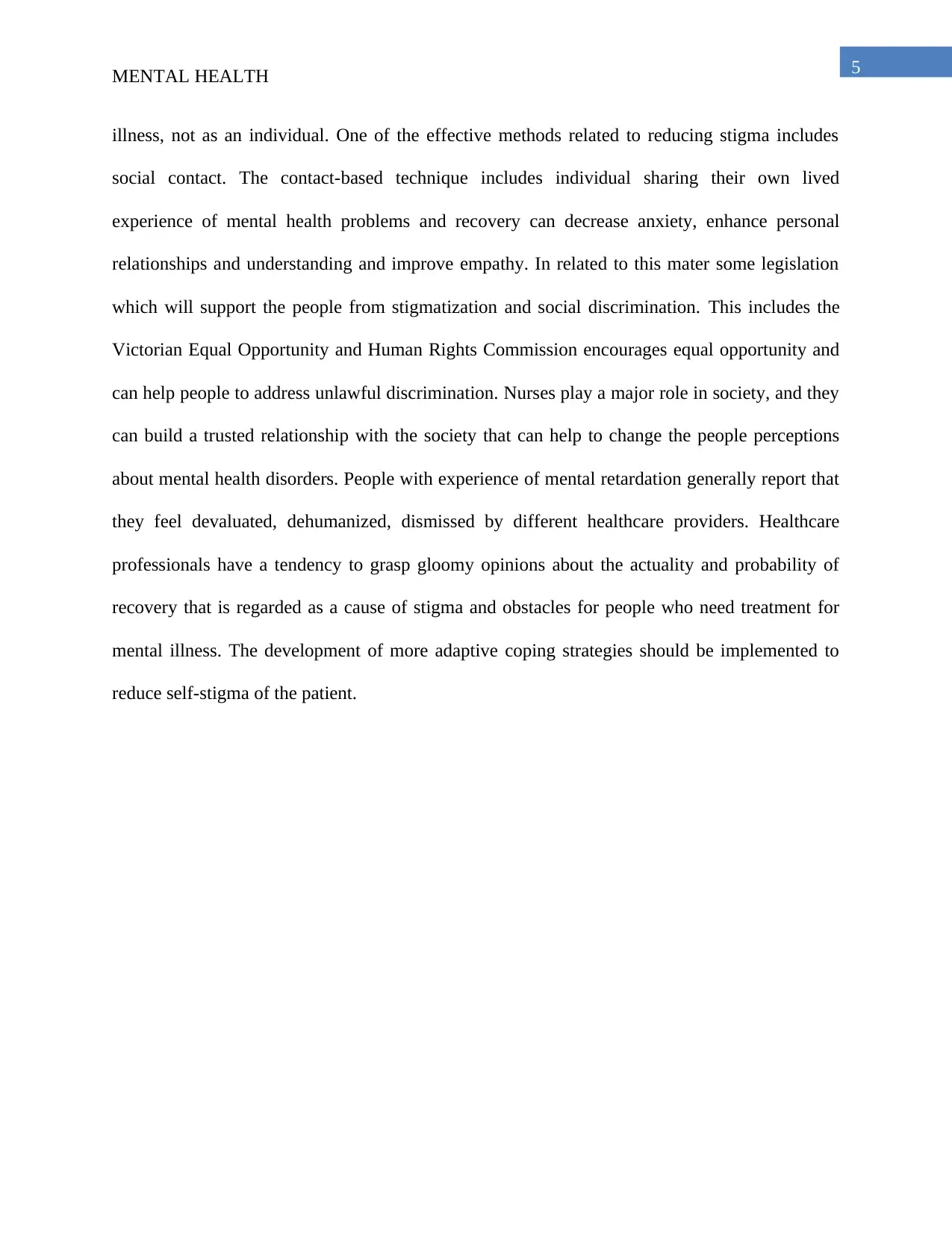
5
MENTAL HEALTH
illness, not as an individual. One of the effective methods related to reducing stigma includes
social contact. The contact-based technique includes individual sharing their own lived
experience of mental health problems and recovery can decrease anxiety, enhance personal
relationships and understanding and improve empathy. In related to this mater some legislation
which will support the people from stigmatization and social discrimination. This includes the
Victorian Equal Opportunity and Human Rights Commission encourages equal opportunity and
can help people to address unlawful discrimination. Nurses play a major role in society, and they
can build a trusted relationship with the society that can help to change the people perceptions
about mental health disorders. People with experience of mental retardation generally report that
they feel devaluated, dehumanized, dismissed by different healthcare providers. Healthcare
professionals have a tendency to grasp gloomy opinions about the actuality and probability of
recovery that is regarded as a cause of stigma and obstacles for people who need treatment for
mental illness. The development of more adaptive coping strategies should be implemented to
reduce self-stigma of the patient.
MENTAL HEALTH
illness, not as an individual. One of the effective methods related to reducing stigma includes
social contact. The contact-based technique includes individual sharing their own lived
experience of mental health problems and recovery can decrease anxiety, enhance personal
relationships and understanding and improve empathy. In related to this mater some legislation
which will support the people from stigmatization and social discrimination. This includes the
Victorian Equal Opportunity and Human Rights Commission encourages equal opportunity and
can help people to address unlawful discrimination. Nurses play a major role in society, and they
can build a trusted relationship with the society that can help to change the people perceptions
about mental health disorders. People with experience of mental retardation generally report that
they feel devaluated, dehumanized, dismissed by different healthcare providers. Healthcare
professionals have a tendency to grasp gloomy opinions about the actuality and probability of
recovery that is regarded as a cause of stigma and obstacles for people who need treatment for
mental illness. The development of more adaptive coping strategies should be implemented to
reduce self-stigma of the patient.
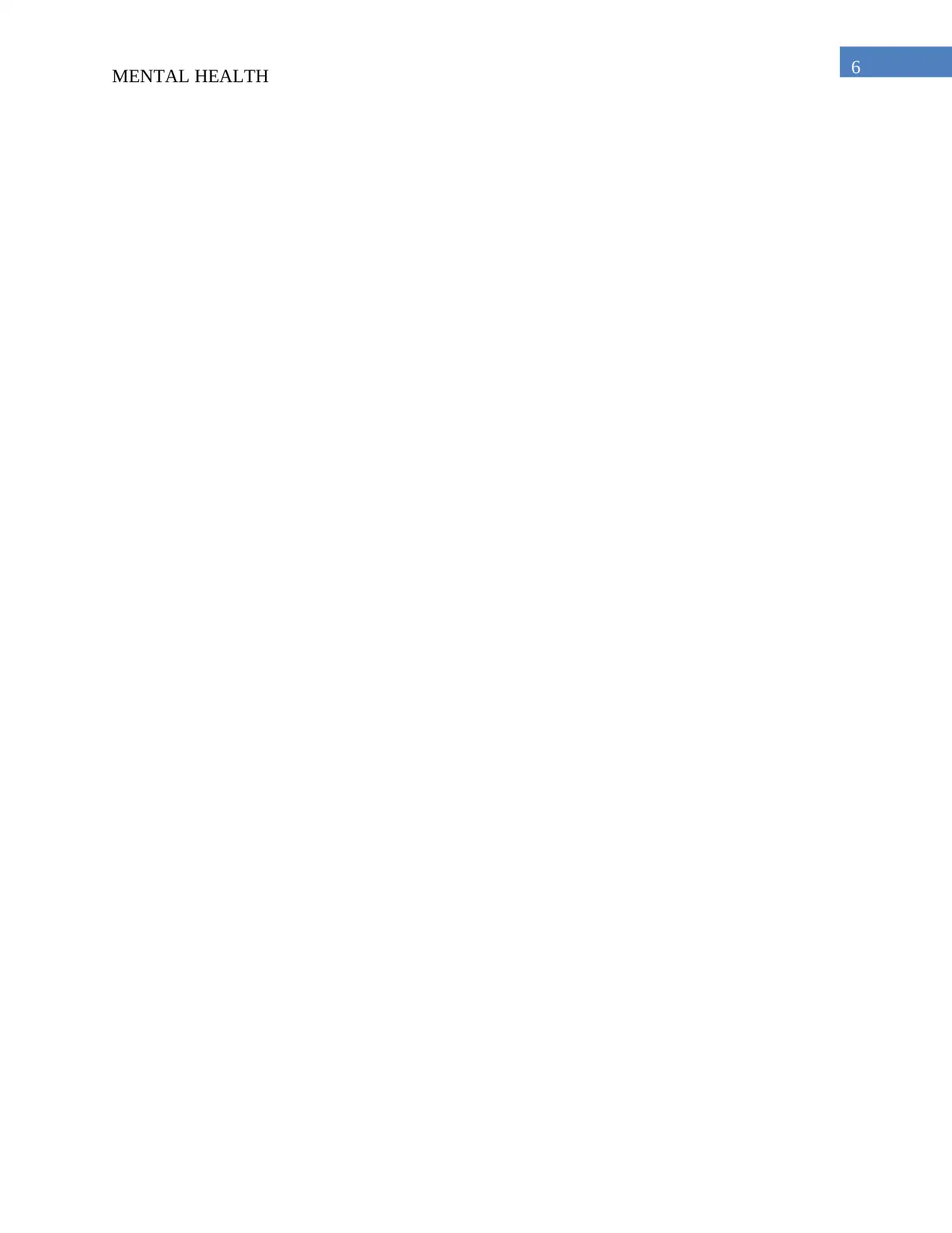
6
MENTAL HEALTH
MENTAL HEALTH
Paraphrase This Document
Need a fresh take? Get an instant paraphrase of this document with our AI Paraphraser
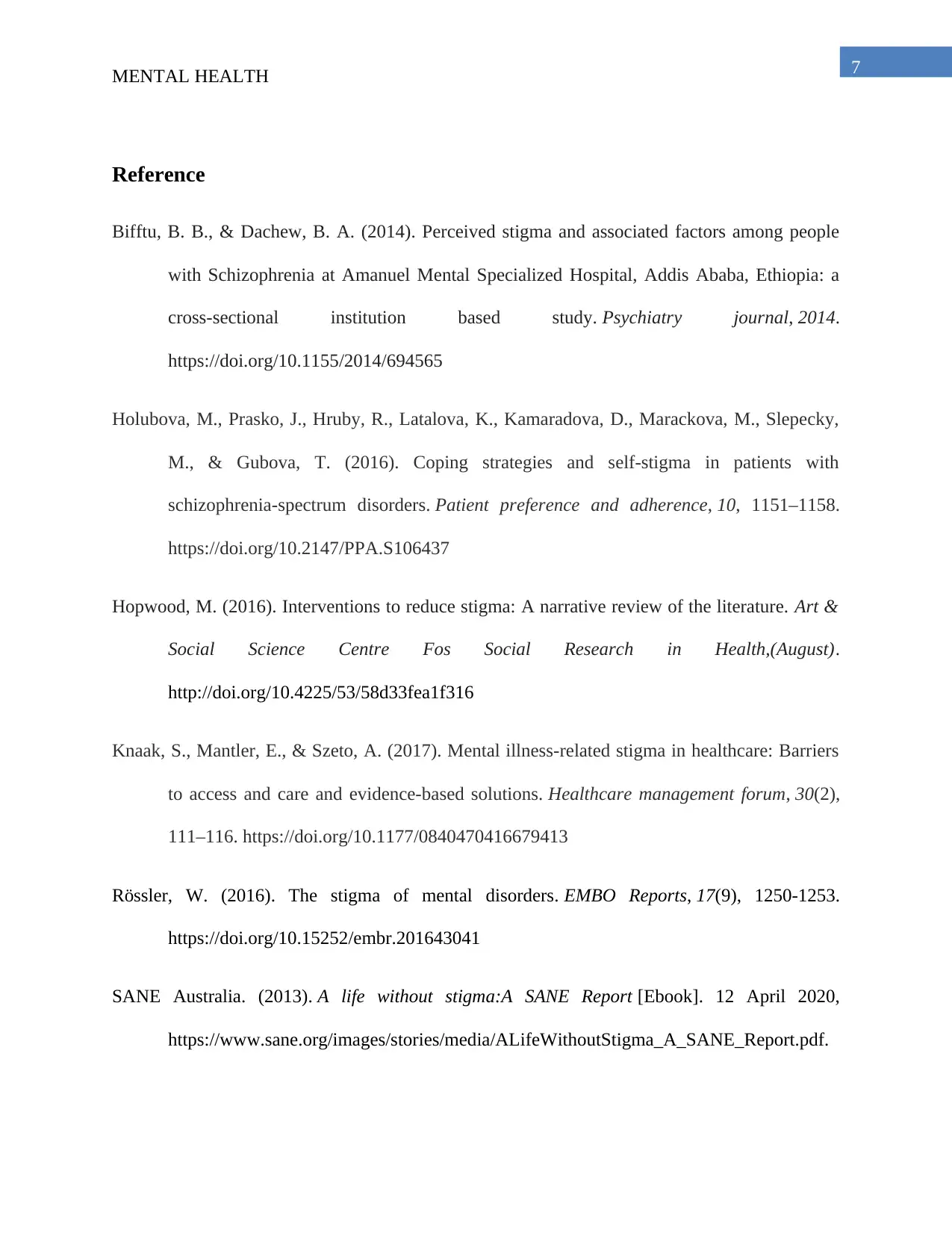
7
MENTAL HEALTH
Reference
Bifftu, B. B., & Dachew, B. A. (2014). Perceived stigma and associated factors among people
with Schizophrenia at Amanuel Mental Specialized Hospital, Addis Ababa, Ethiopia: a
cross-sectional institution based study. Psychiatry journal, 2014.
https://doi.org/10.1155/2014/694565
Holubova, M., Prasko, J., Hruby, R., Latalova, K., Kamaradova, D., Marackova, M., Slepecky,
M., & Gubova, T. (2016). Coping strategies and self-stigma in patients with
schizophrenia-spectrum disorders. Patient preference and adherence, 10, 1151–1158.
https://doi.org/10.2147/PPA.S106437
Hopwood, M. (2016). Interventions to reduce stigma: A narrative review of the literature. Art &
Social Science Centre Fos Social Research in Health,(August).
http://doi.org/10.4225/53/58d33fea1f316
Knaak, S., Mantler, E., & Szeto, A. (2017). Mental illness-related stigma in healthcare: Barriers
to access and care and evidence-based solutions. Healthcare management forum, 30(2),
111–116. https://doi.org/10.1177/0840470416679413
Rössler, W. (2016). The stigma of mental disorders. EMBO Reports, 17(9), 1250-1253.
https://doi.org/10.15252/embr.201643041
SANE Australia. (2013). A life without stigma:A SANE Report [Ebook]. 12 April 2020,
https://www.sane.org/images/stories/media/ALifeWithoutStigma_A_SANE_Report.pdf.
MENTAL HEALTH
Reference
Bifftu, B. B., & Dachew, B. A. (2014). Perceived stigma and associated factors among people
with Schizophrenia at Amanuel Mental Specialized Hospital, Addis Ababa, Ethiopia: a
cross-sectional institution based study. Psychiatry journal, 2014.
https://doi.org/10.1155/2014/694565
Holubova, M., Prasko, J., Hruby, R., Latalova, K., Kamaradova, D., Marackova, M., Slepecky,
M., & Gubova, T. (2016). Coping strategies and self-stigma in patients with
schizophrenia-spectrum disorders. Patient preference and adherence, 10, 1151–1158.
https://doi.org/10.2147/PPA.S106437
Hopwood, M. (2016). Interventions to reduce stigma: A narrative review of the literature. Art &
Social Science Centre Fos Social Research in Health,(August).
http://doi.org/10.4225/53/58d33fea1f316
Knaak, S., Mantler, E., & Szeto, A. (2017). Mental illness-related stigma in healthcare: Barriers
to access and care and evidence-based solutions. Healthcare management forum, 30(2),
111–116. https://doi.org/10.1177/0840470416679413
Rössler, W. (2016). The stigma of mental disorders. EMBO Reports, 17(9), 1250-1253.
https://doi.org/10.15252/embr.201643041
SANE Australia. (2013). A life without stigma:A SANE Report [Ebook]. 12 April 2020,
https://www.sane.org/images/stories/media/ALifeWithoutStigma_A_SANE_Report.pdf.
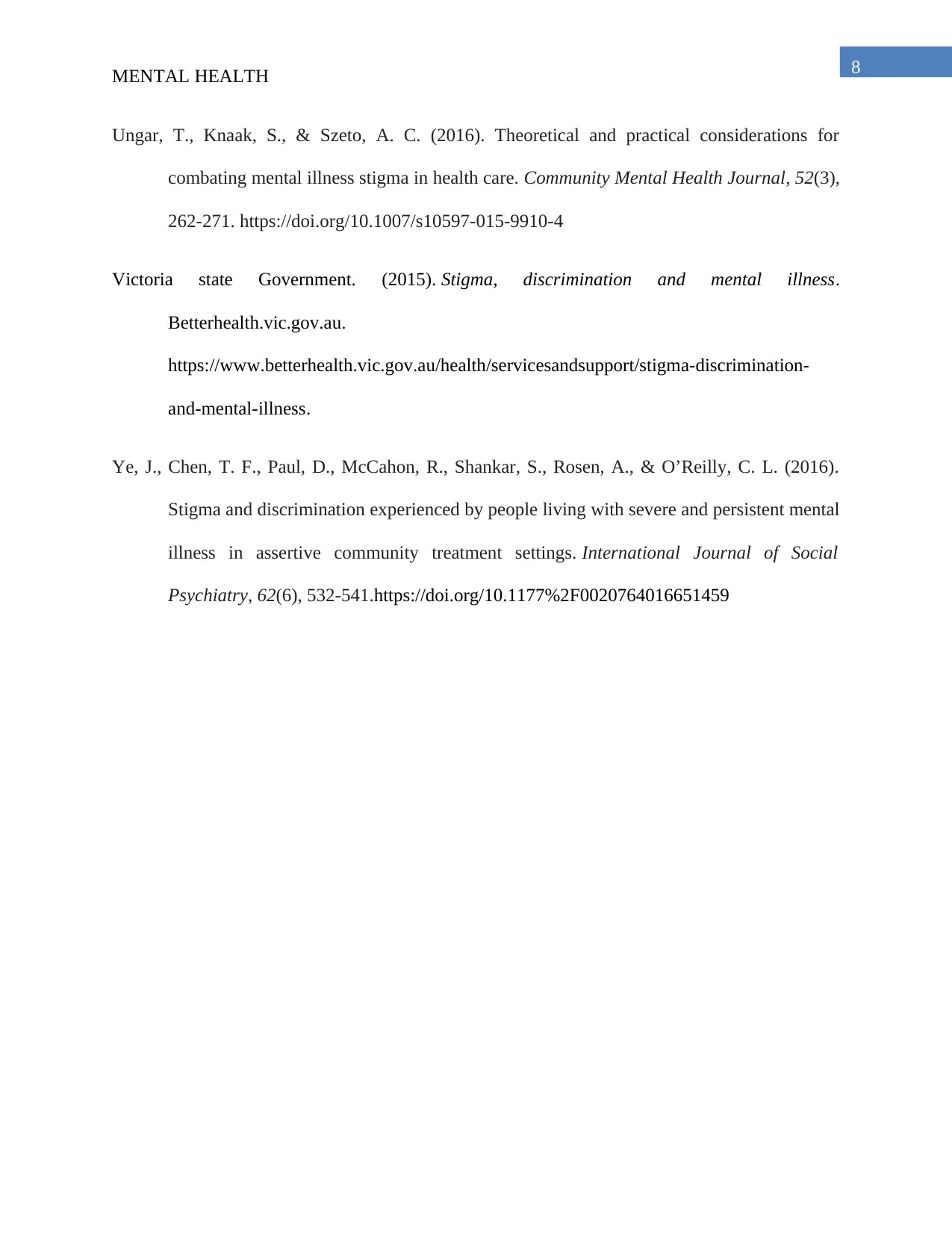
8
MENTAL HEALTH
Ungar, T., Knaak, S., & Szeto, A. C. (2016). Theoretical and practical considerations for
combating mental illness stigma in health care. Community Mental Health Journal, 52(3),
262-271. https://doi.org/10.1007/s10597-015-9910-4
Victoria state Government. (2015). Stigma, discrimination and mental illness.
Betterhealth.vic.gov.au.
https://www.betterhealth.vic.gov.au/health/servicesandsupport/stigma-discrimination-
and-mental-illness.
Ye, J., Chen, T. F., Paul, D., McCahon, R., Shankar, S., Rosen, A., & O’Reilly, C. L. (2016).
Stigma and discrimination experienced by people living with severe and persistent mental
illness in assertive community treatment settings. International Journal of Social
Psychiatry, 62(6), 532-541.https://doi.org/10.1177%2F0020764016651459
MENTAL HEALTH
Ungar, T., Knaak, S., & Szeto, A. C. (2016). Theoretical and practical considerations for
combating mental illness stigma in health care. Community Mental Health Journal, 52(3),
262-271. https://doi.org/10.1007/s10597-015-9910-4
Victoria state Government. (2015). Stigma, discrimination and mental illness.
Betterhealth.vic.gov.au.
https://www.betterhealth.vic.gov.au/health/servicesandsupport/stigma-discrimination-
and-mental-illness.
Ye, J., Chen, T. F., Paul, D., McCahon, R., Shankar, S., Rosen, A., & O’Reilly, C. L. (2016).
Stigma and discrimination experienced by people living with severe and persistent mental
illness in assertive community treatment settings. International Journal of Social
Psychiatry, 62(6), 532-541.https://doi.org/10.1177%2F0020764016651459
1 out of 9
Related Documents
Your All-in-One AI-Powered Toolkit for Academic Success.
+13062052269
info@desklib.com
Available 24*7 on WhatsApp / Email
![[object Object]](/_next/static/media/star-bottom.7253800d.svg)
Unlock your academic potential
© 2024 | Zucol Services PVT LTD | All rights reserved.





